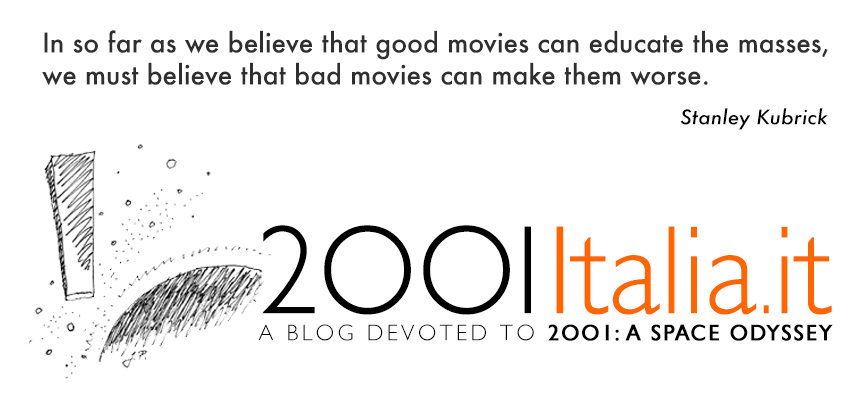Alle nove di sera del 17 maggio 1964, dopo una giornata intera di lavoro sulla sceneggiatura di
2001 (all'epoca ancora conosciuto come "
Journey Beyond The Stars") Stanley Kubrick e Arthur C. Clarke andarono a prendere una boccata d'aria sulla terrazza dell'appartamento dei Kubrick sull'84esima strada a New York.
Durante la giornata i due erano giunti ad un importante accordo: Clarke si era fatto convincere da Kubrick (dopo una iniziale riluttanza) a ritardare il suo ritorno a Ceylon finché il soggetto da presentare alla MGM per ottenere il finanziamento per il film non fosse stato completato. Regista e scrittore si strinsero la mano e, accompagnati dalla moglie del regista Christiane, uscirono a prendere una boccata d'aria. Il cielo era sereno e la luna piena.
Uno degli argomenti più spesso dibattuti dai due in quel primo mese di frequentazione era l'esistenza o meno degli UFO. Clarke era sicuro di essere riuscito a convincere Kubrick, inizialmente possibilista riguardo la loro origine extraterrestre, che si trattava solo di oggetti volanti non identificati - U.F.O. (
Unidentidied flying objects), appunto.
Nelle parole di Clarke, dalla sua biografia
Visionary:
Stanley era pericolosamente vicino a credere all'esistenza dei dischi volanti, e io sentii di essere arrivato al momento giusto per salvarlo da questa misera fine.
Immaginatevi quindi la sorpresa quando proprio quella notte, mentre i tre conversavano sulla terrazza, nel cielo newyorkese apparve un oggetto più luminoso delle stelle circostanti che si spostò, si fermò per un paio di minuti, poi riprese a muoversi, scomparendo dietro ad un edificio nel giro di pochi secondi. Kubrick e Clarke presero il
telescopio Questar 3.5 del regista e si precipitarono sul tetto, per avere una vista maggiore dell'oggetto: ma anche visto attraverso il telescopio l'oggetto era solo un punto di luce, che scomparve di nuovo in direzione nordest.
A dir la verità i due avevano subito pensato potesse trattarsi il
satellite Echo (il primo satellite artificiale per telecomunicazioni, in realtà una semplice sfera gonfiabile di 30 mt. rivestito da una pellicola in grado di riflettere le onde radio) ma controllando sul
New York Times, che aveva una sezione con i passaggi dei satelliti sul cielo americano per gli astrofili, vennero a sapere che il suo passaggio era previsto solo per le 23.03, ovvero due ore dopo. Ciò che rese perplesso Kubrick fu il fatto che secondo l'Hayden Planetarium di New York, a cui Clarke telefonò uno o due giorni dopo, Echo si era presentato regolarmente all'ora stabilita.
Clarke ricorda l'avvenimento - con la consueta dose di umorismo - nella sua biografia
Visionary:
Ho ancora in mente, e lo dico con una certa timidezza, il senso di sgomento ed eccitazione che sentii quella sera. E anche un pensiero che mi attraversò il cervello: "Non può essere una coincidenza, Loro vogliono impedirci di fare questo film!"
Cosa poteva essere? Il fatto che l'oggetto si fosse fermato per qualche secondo sembrava escludere che si potesse trattare di un satellite in orbita. Kubrick, alla ricerca di una spiegazione definitiva, e non convinto delle spiegazioni più logiche proposte da Clarke, richiese e compilò il questionario
"U.S. Air Force Technical Information" per i fenomeni aerei non identificati e lo riconsegnò il 16 giugno del 1964:
Il modulo sugli oggetti volanti non identificati compilato da Kubrick il 16 giugno del 1964, e il suo disegno con la ricostruzione dell'avvistamento. Fonte: Catalogo della mostra di Stanley Kubrick, Giunti Editore
Come spesso accade, la soluzione era più semplice del previsto. Più avanti, Kubrick scoprì che il
New York Times aveva indicato un'ora sbagliata per il passaggio di Echo su New York, traendo in inganno di fatto anche l'Hayden Planetarium; la questione si risolse definitivamente quando l'USAF rispose al questionario compilato dal regista indicando l'ora esatta del passaggio su New York.
Si era trattato, senza alcun dubbio, di Echo, e il fatto che il satellite stesse raggiungendo il suo zenit aveva dato l'illusione che fosse rimasto immobile per qualche istante.
Il satellite Echo durante un test di gonfiaggio, 1960 (fonte)
Antony Frewin, l'assistente di Kubrick che ha riportato l'aneddoto sul suo libro
Interviste Extraterrestri, commenta così:
Il mistero era risolto, ma come osservò Kubrick, se lui e Arthur non avessero cercato maggiori informazioni avrebbero passato il resto della loro vita parlando di un UFO se non addirittura di un'astronave extraterrestre, alimentando in tal modo le credenze popolari.
Arthur C. Clarke tornò sull'argomento, anni dopo, nel libro
Greetings, Carbon-based bipeds:
Forse quella sera Stanley ed io eravamo in preda ad un tale stato di euforia [dovuto al lavoro sul film] da non essere abbastanza critici come avremmo dovuto...
Per Kubrick, però, la prudenza non era mai troppa: l'anno seguente, durante la pre-produzione di
2001, pensò che per non rovinare di assicurarsi dai Lloyds di Londra contro la scoperta di intelligenza extraterrestre prima dell'uscita del film, ... (I Lloyds rifiutarono).
Stanley Kubrick, 1967-68 (fonte)
Riguardo all'equazione UFO-visitatori alieni, tuttavia, il regista rimase possibilista, come dimostra la famosa intervista concessa a
Playboy dopo l'uscita di
2001 (1968):
Penso che il 2% di avvistamenti rimasti inspiegati, per stessa ammissione dell'Aviazione, dal progetto Blue Book dovrebbero portare a una ricerca più seria sull'argomento. [...] Un segno di speranza sul fatto che ci possa essere una discussione più approfondita sul tema è la tardiva ma esemplare conversione del dottor J. Allen Hynek, dal 1948 consulente dell'Aviazione Militare sugli UFO.
[...] Hynek, che una volta ridicolizzava gli avvistamenti di oggetti non identificati, oggi crede che meritino la massima attenzione, e addirittura ammette che le prove disponibili indicano una possibile connessione con la vita extraterrestre. La sua posizione è la seguente: "Sarei sorpreso se uno studio intensivo non portasse a nessun risultato. Al contrario, penso che l'umanità potrebbe essere all'inizio della più grande avventura da quando l'Intelligenza è nata e ha cominciato a rivolgere la sua attenzione verso l'Universo". Sono d'accordo con lui.
Aggiornamento (21/5/2014 h.11.20) ho corretto le frasi riguardo all'Hayden Planetarium, che rendevano poco chiaro il passaggio.

























